Euphorbia esula
Description
- Native to Europe and Asia
- Introduced as an ornamental plant in the early 1800’s
- Stems are clumped, can reach 1 m tall
- Roots can extend 4.5 m laterally and 9 m deep
- Each plant can produce over 130,000 seeds!
- Flowers are tiny and yellow. Uniquely, they lack sepals and petals.
- Flowers are surrounded by two green, heart-shaped bracts which may appear to be part of the flower.

Consequences of invasion
- Stems contain a milky sap containing latex that is toxic to livestock and can cause skin irritation on humans.
- The sap can also cause temporary blindness if it gets in your eyes
Status in the CKISS region
- Leafy spurge is classified as Eradicate on the CKISS Annual Priority List.
- It has only been found in the Creston and Lower Arrow Invasive Plant Management Areas of our region. Because of its limited distribution, eradication is feasible.
- The goal is to eradicate these sites and prevent the species from spreading to new areas.
- Please report findings of this species immediately.
- To learn more about how CKISS classifies and manages invasive species, see our Invasive Species Priority Lists page.
Integrated pest management options
Prevention
- Use weed-free hay.
- If animals were in an area infested with leafy spurge, they should be isolated for a week so that the seeds may travel through their body.
- If a vehicle has travelled through an infested area, wash the underside and tires thoroughly.
- Become Plantwise and learn about Grow Me Instead
Mechanical
- Hand pulling is effective with small infestations that are young. Be careful to avoid skin irritation by wearing gloves and washing hands. Dispose of your invasive plant material correctly. Click here for more info on disposal.
- Mowing can be effective in preventing seed production, if done repeatedly and at the right times.
Chemical and biocontrol
- There are chemical and biocontrol agents available to control this plant. Consult a professional to see if these options may be suitable for your situation.


